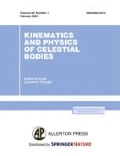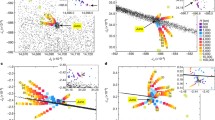Abstract—
The equator of Saturn is inclined to the orbital plane by an angle of 26.75°, and the period of revolution around the Sun is 29.45 years. Since the orbital eccentricity of Saturn is e ≈ 0.056 and Saturn passes the perihelion and the aphelion during the summer epoch in its southern and northern hemispheres, respectively, the southern hemisphere receives 25% more energy from the Sun than the northern one. This factor influences the physical characteristics and vertical structure of the atmosphere. Changes on Saturn were registered and they were related to the seasonal influx of the solar energy. To analyze the effect, the results of observations at the equinox moments in 1966, 1980, 1995, and 2010 were used. Latitudinal differences in the absorption by methane across the disk showed a significant asymmetry between the northern and southern hemispheres. Moreover, in the opposite hemispheres, the absorption changes in different ways. Under identical conditions formed in the previous history of the planet in 1966 and 1995, the absorption in the northern summer hemisphere was greater than that in the southern one. A reverse effect was observed in 1980 when the absorption was large in the southern summer hemisphere. The last equinox on Saturn was in 2009. It is supposed that its effect would be similar to the results of 1980. However, in contrast to the pronounced asymmetry in absorption between the hemispheres in 1966, 1980, and 1995, hardly any difference in absorption between the hemispheres was observed during the 2009 equinox. Moreover, in the northern winter hemisphere, the absorption did not decrease, while it markedly increased in the summer southern hemisphere. A peculiar feature of the 2009 equinox itself was that, unlike the previous three equinoxes, it occurred during the solar activity minimum. A joint analysis of the results of observations performed in 1980 and 2010 by the Voyager and Cassini probes, respectively, showed that, for one Saturnian year, the tropical atmosphere in the tropopause warmed up by 10 K. Taking into account these differences and the fact that the solar activity index in 1980 and 2010 was R = 0 and more than 150, respectively, the radiative constant of the hydrogen–helium atmosphere of Saturn is estimated at ~4.5 terrestrial years. However, the warming in the tropopause changed the atmospheric stratification and the stability and influenced the large-scale dynamics of the upper troposphere in 2010.



Similar content being viewed by others
REFERENCES
K. H. Baines, P. Drossart, T. W. Momary, et al., “The atmospheres of Saturn and Titan in the near-infrared first results of Cassini/VIMS,” Earth, Moon, Planets 96, 119–147 (2005).
D. Bardet, A. Spiga, S. Guerlet, et al., “Global climate modeling of Saturn’s atmosphere. Part IV: Stratospheric equatorial oscillation,” Icarus 354, 114042 (2021).
B. Bezard, D. Gautier, and B. Conrath, “A seasonal model of the Saturnian upper troposphere: Comparison with Voyager infrared measurements,” Icarus 60, 274–288 (1984).
S. Cabanes, A. Spiga, and R. M. B. Young, “Global climate modeling of Saturn’s atmosphere. Part III: Global statistical picture of zonostrophic turbulence in high-resolution 3D-turbulent simulations,” Icarus 345, 113705 (2020).
R. D. Cess and J. Cocran, “A Saturnian stratospheric seasonal climate model,” Icarus 38, 349–357 (1979).
A. L. Cochran and W. D. Cochran, “Longitudinal variability of methane and ammonia bands on Saturn,” Icarus 48, 488–495 (1981).
B. J. Conrath and J. A. Pirraglia, “Thermal structure of Saturn from Voyager infrared measurements — Implications for atmospheric dynamics,” Icarus 53, 286–292 (1983).
J. M. Dlugach, A. V. Morozhenko, A. P. Vid’machenko, and E. G. Yanovitskij, “Investigations of the optical properties of Saturn’s atmosphere carried out at the Main Astronomical Observatory of the Ukrainian Academy of Sciences,” Icarus 54, 319–336 (1983).
S. Edgington, Atreya S. Wilson, et al., “Photochemistry and heating in Saturn’s atmosphere: Ring shadow and ring reflection,” in Proc. EPSC-DPS Joint Meeting 2019, Geneva, Switzerland, Sept. 15–20, 2019, paper id. EPSC-DPS2019-954.
L. N. Fletcher, R. K. Achterberg, Th. K. Greathouse, et al., “Seasonal change on Saturn from Cassini/CIRS observations 2004–2009,” Icarus 208, 337–352 (2010).
R. Hueso, A. Sánchez-Lavega, J. F. Rojas, et al., “Saturn atmospheric dynamics one year after Cassini: Long-lived features and time variations in the drift of the Hexagon,” Icarus 336, 113429 (2020).
E. Karkoschka and M. G. Tomasko, “Saturn’s upper troposphere 1986–1989,” Icarus 97, 161–181 (1992).
E. Karkoschka and M. Tomasko, “Saturn’s vertical and latitudinal cloud structure 1991–2004 from HST imaging in 30 filters,” Icarus 179, 195–221 (2005).
V. M. Klimenko, A. V. Morozhenko, and A. P. Vid’machenko, “Phase effect for the brightness coefficient of the central disk of Saturn and features of Jupiter’s disk,” Icarus 42, 354–357 (1980).
N. F. Leigh, “Saturn’s seasonal atmosphere,” Astron. Geophys. 58, 4.26–4.30 (2017).
L. Liming, K. A. Richard, J. C. Barney, et al., “Strong temporal variation over one Saturnian year: From Voyager to Cassini,” Sci. Rep. 3, 1–5 (2013).
M. Marin, “Photometric photographique de Saturne,” J. Obs. 51, 179–191 (1968).
S. Perez-Hoyos, A. Sanchez-Lavega, R. G. French, and J. F. Rojas, “Saturn’s cloud structure and temporal evolution from ten years of Hubble Space Telescope images (1994–2003),” Icarus 176, 155–174 (2005).
M. J. Price and O. G. Franz, “Saturn: UBV photoelectric pinhole scans of the disk. II,” Icarus 44, 657–667 (1980).
A. Sanchez-Lavega, J. Lecacheux, F. Colas, and P. Laques, “Temporal behavior of cloud morphologies and motions in Saturn’s atmosphere,” J. Geophys. Res.: Planets 98, 18,857–18,872 (1993).
A. Sanchez-Lavega and J. A. Quesada, “A survey of Saturn’s northern hemisphere from 1979 to 1987,” Planet. Space Sci. 36, 1381–1389 (1988).
J. A. Sinclair, P. G. J. Irwin, L. N. Fletcher, et al., “Seasonal variations of temperature, acetylene and ethane in Saturn’s atmosphere from 2005 to 2010, as observed by Cassini-CIRS,” Icarus 225, 257–271 (2012).
A. Spiga, S. Guerlet, E. Millour, et al., “Global climate modeling of Saturn’s atmosphere. Part II: Multi-annual high-resolution dynamical simulations,” Icarus 335, 113377 (2020).
A. F. Steklov, A. P. Vidmachenko, and N. F. Minyailo, “Seasonal variations in the atmosphere of Saturn,” Sov. Astron. Lett. 9, 135–136 (1983).
V. G. Teifel, “Calculation of the depths of absorption lines and bands on the disk of a planet surrounded by a semi-infinite homogeneous atmosphere,” Sol. Syst. Res. 9, 57 (1975).
V. G. Teifel, “Optical properties and structure of Saturn’s atmosphere,” Sol. Syst. Res. 14, 1–16 (1980).
V. G. Tejfel, A. M. Karimov, and G. A. Kharitonova, “Comparison of the latitudinal variations of the methane absorption,” Astron. Tsirk. 1573, 1–2 (2010).
V. G. Teifel, L. A. Usol’tseva, and G. A. Kharitonova, “Optical properties and structure of Saturn’s atmosphere. II. Latitudinal variations of absorption in the 0.62-mu CH4 band and characteristics of the planet in the near ultraviolet,” Sov. Astron. 17, 108–111 (1973).
V. G. Tejfel, V. D. Vdovichenko, A. M. Karimov, et al., “The space-time variations of the molecular absorption bands on Jupiter and Saturn from 1995–2007 observations,” in Proc. 39th Lunar and Planetary Science Conf., League City, Texas, Mar. 10–14, 2008 (Lunar and Planetary Inst., League City, Tex., 2008), LPI Contribution No. 1391, 1530.
V. G. Tejfel, V. D. Vdovichenko, A. M. Karimov, et al., “Saturn at and between the equinoxes 1995 and 2009,” in Proc. 41st Lunar and Planetary Science Conf., Woodlands, Texas, Mar. 1–5, 2010 (Lunar and Planetary Inst., Houston, Tex., 2010), LPI Contribution No. 1533, 1250.
V. Tejfel, V. Vdovichenko, A. Karimov, et al., “Saturn CCD-spectrophotometry in 2009 and 2010 — A comparison of near- and post-equinox latitudinal distribution of molecular absorption,” in Proc. European Planetary Science Congr. 2010, Rome, Italy, Sept. 20–24, 2010, EPSC. 5. 322.
T. Temma, N. J. Chanover, A. A. Simon-Miller, et al., “Vertical structure modeling of Saturn’s equatorial region using high spectral resolution imaging,” Icarus 175, 464–489 (2005).
M. G. Tomasko, R. A. West, G. S. Orton, and V. G. Teifel, “Clouds and aerosols in Saturn’s atmosphere,” in Saturn (Univ. of Arizona Press, Tucson, Ariz., 1984), pp. 150–194.
L. Trafton, “Saturn: Long-term variation of H2, and CH4, absorptions,” Icarus 31, 369–384 (1977).
L. Trafton, “Long-term changes in Saturn’s troposphere,” Icarus 63, 374–405 (1985).
A. P. Vidmachenko, “Reflectivity of Saturn’s south equatorial region from 1977 through 1981,” Sol. Syst. Res. 18, 123–128 (1985).
A. P. Vidmachenko, “Activity of processes in the atmosphere of Jupiter,” Kinematics Phys. Celestial Bodies 1 (5), 101–102 (1985).
A. P. Vidmachenko, “Possible effect of the rings on the photometric properties of Saturn’s cloud layer,” Kinematics Phys. Celestial Bodies 1 (6), 12–15 (1985).
A. P. Vid’machenko, “Manifestation of seasonal variations in the atmosphere of Saturn,” Kinematics Phys. Celestial Bodies 3 (6), 9–12 (1987).
A. P. Vidmachenko, “Giant planets — Theoretical and observational aspects,” Astron. Vestn. 25, 277–292 (1991).
A. P. Vid’machenko, “Temporal changes in methane absorption in Jupiter’s atmosphere,” Kinematics Phys. Celestial Bodies 13 (6), 21–25 (1997).
A. P. Vid’machenko, “Variations in reflective characteristics of Jupiter’s atmosphere,” Sol. Syst. Res. 33, 464–469 (1999).
A. P. Vidmachenko, “Seasonal variations in the optical characteristics of Saturn’s atmosphere,” Kinematics Phys. Celestial Bodies 15, 320–331 (1999).
A. P. Vidmachenko, “Influence of solar activity on seasonal variations of methane absorption in the atmosphere of Saturn,” Kinematics Phys. Celestial Bodies 31, 131–140 (2015).
A. P. Vidmachenko, “Seasons on Saturn. 1. Changes in reflecting characteristics of the atmosphere at 1964—2012,” Astron. Sch. Rep. 11, 1–14 (2015).
A. P. Vidmachenko, “Seasons on Saturn. II. Influence of solar activity on variation of methane absorption,” Astron. Sch. Rep. 11, 15–23 (2015).
A. P. Vidmachenko, “Seasonal changes on Jupiter: 1. Factor of activity of the hemispheres,” Kinematics Phys. Celestial Bodies 32, 189–195 (2016).
A. P. Vidmachenko, “Seasonal changes on Jupiter: 2. Influence of the planet exposure to the Sun,” Kinematics Phys. Celestial Bodies 32, 283–293 (2016).
A. P. Vidmachenko, Zh. M. Dlugach, and A. V. Morozhenko, “Nature of the optical nonuniformity in Saturn’s disk,” Sol. Syst. Res. 17, 164–171 (1984).
A. P. Vidmachenko, A. V. Morozhenko, and V. M. Klimenko, “Phase effect for the brightness coefficient of the central disk of Saturn and features of Jupiter’s disk,” Icarus 42, 354–357 (1980).
A. P. Vidmachenko, A. F. Steklov, and N. F. Minyajlo, “Seasonal activity on Jupiter,” Sov. Astron. Lett. 10, 289–290 (1984).
R. A. West, M. G. Tomasko, B. A. Smith, et al., “Spatially resolved methane band photometry of Saturn. I — Absolute reflectivity and center-to-limb variations in the 6190-, 7250-, and 8900-Å bands,” Icarus 51, 51–64 (1982).
Author information
Authors and Affiliations
Corresponding author
Additional information
Translated by E. Petrova
About this article
Cite this article
Vidmachenko, A.P. Features of Saturn’s Equinox in 2010. Kinemat. Phys. Celest. Bodies 37, 33–40 (2021). https://doi.org/10.3103/S0884591321010062
Received:
Revised:
Accepted:
Published:
Issue Date:
DOI: https://doi.org/10.3103/S0884591321010062




